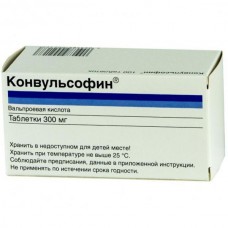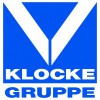Expiration date: 12/2026
Structure and Composition:
Tablets. One tablet contains active substance:
calcium valproate dihydrate 333 mg
(Corresponds to 300 mg of calcium valproate and 265 mg valproic acid)
excipients: gelatin - Potato starch 11 mg - 166.4 mg of silicon dioxide - Talc 16.5 mg - 17.6 mg Magnesium stearate - 5.5 mg
in plastic bottles of 100 pcs. In the paper cartons 1 bottle.
Description pharmaceutical form:
White, round, flat tablets with bevelled and Valium, with a smooth surface, with solid edges and the same species.
Pharmachologic effect:
It inhibits GABA transferase and increases the content of GABA (inhibitory neurotransmitter) in the CNS. It decreases anxiety and seizure of motor areas of the brain, slowing the spread of excitation in the epileptic focus crust.
According to another hypothesis, it acts on sites of postsynaptic receptors, mimicking or enhancing the inhibitory effect of GABA. Possible direct effect on the activity of the membrane due to changes in potassium conductance. It improves mood and mental state of patients has anti-arrhythmic activity. Highly effective in absence seizures and temporal psevdoabsansah little - with psychomotor seizures.
Pharmacokinetics:
Absorption - high, the food slightly reduces the absorption rate of bioavailability - 100%. Time to reach Cmax for tablets -. 3-4 hours Css achieved 2-4 days receive (depending on the intervals between doses).
Therapeutic plasma levels range between 50-150 mg / liter. The volume of distribution - 0.2 l / kg. Binding protein - 90-95% - at a concentration in the blood plasma of up to 50 mg / l 80-85% - at a concentration of 50-100 mg / l (in uremia, cirrhosis, hypoproteinemia and reduced protein binding). It penetrates through the placental barrier and the blood-brain barrier, excreted in breast milk (concentration in breast milk is 1-10% kontsentatsii in maternal blood plasma). The content in the cerebrospinal fluid correlated with the value of the unbound protein fraction. It is metabolized by oxidation and glucuronidation in the liver. T1 / 2 -. 12-16 hours of valproic acid (3.1%) and its metabolites (as conjugates, oxidation products, including ketometabolitov) excreted by the kidneys in small amounts - from faeces and exhaled air.
In combination with other drugs T1 / 2 can be 6-8 hours due to the induction of metabolic enzymes in patients with impaired liver function, elderly patients and children up to 18 months - can be significantly prolonged.
Indications:
Epilepsy various origins, generalized and partial seizures. Seizures on the background of organic brain disease. Changes in the nature and behavior (due to epilepsy). Manic-depressive psychosis with bipolar course, not amenable to treatment with drugs lithium and other drugs. The specific syndromes (West, Lennox-Gastaut syndrome).
Contraindications:
Hypersensitivity, hepatic failure, acute and chronic hepatitis, disorders of the pancreas, porphyria, bleeding diathesis, thrombocytopenia, children's age (up to 3 years), history of liver disease.
Be wary - bone marrow aplasia, pathological changes in the blood, organic brain disease, hypoproteinemia, renal failure, pregnancy, lactation.
Application of pregnancy and breastfeeding:
When using valproic acid in early pregnancy increases the risk of cleft neural tube in the embryo (myelomeningocele). At the same time can be marked other fetal abnormalities. The risk of congenital malformations in the fetus is increased by combined use Convulsofin with other antiepileptic drugs. In the case where it is impossible to abandon the therapy with valproic acid during pregnancy, I trimester, the physician's instructions, the drug is used in very low doses, and between 20 and 40 day of pregnancy daily dose it is partitioned into several smaller single doses during the day. In addition, it is recommended regularly control the concentration of drugs in the blood serum. For the purpose of early diagnosis of fetal abnormalities is recommended ultrasound examination and alpha 1-fetoproteinovy ??test.
During the period of breast-feeding should be careful.
Side effect:
CNS: fatigue, tremor, rarely - changes in behavior, mood or mental state (depression, fatigue, hallucinations, aggression, hyperactivity condition, psychosis, unusual excitement, restlessness or irritability), ataxia, dizziness, somnolence, headache , encephalopathy, dysarthria, enuresis, stupor, impaired consciousness, coma.
From the senses: diplopia, nystagmus, flashing "flies" before the eyes, hearing impairment.
On the part of the digestive system: nausea, vomiting, gastralgia, anorexia or increased appetite, diarrhea, hepatitis rarely - constipation, pancreatitis, down to heavy defeats fatal (in the first 6 months of treatment, most - at 2-12 weeks).
From the side of hematopoiesis and hemostasis system: anemia, leukopenia, thrombocytopenia, decreased fibrinogen, platelet aggregation and blood clotting, accompanied by a prolonged bleeding time, petechiae, bruising, hematoma, bleeding and others.
From a metabolism: a decrease or increase in body weight.
Allergic reactions: skin rash, urticaria, angioedema, photosensitivity, Stevens-Johnson syndrome.
Laboratory findings: hypercreatininemia, hyperammonemia, giperglitsinemiya, hyperbilirubinemia, a slight increase in liver transaminases, lactate dehydrogenase (dose-dependent).
From endocrine system: dysmenorrhea, secondary amenorrhea, breast enlargement, galactorrhea.
Other: peripheral edema, alopecia.
Drug Interactions:
When concomitant administration of valproic acid with ethanol and other drugs depressing the central nervous system may increase CNS depression with barbiturates or primidone - increasing their concentration in blood plasma with salicylates - strengthening effects of valproic acid (the displacement of its association with plasma proteins).
In a joint application with phenobarbital, phenytoin (and, possibly, other antiepileptic drugs c-hydantoin derivatives), carbamazepine, valproic acid, mefloquine decreased blood serum (accelerating metabolism).
Combination with anticoagulants (indandiona and coumarin derivatives), heparin, antiplatelet agents, and thrombolytic agents (acetylsalicylic acid derivatives and other platelet aggregation inhibitors) increases the risk of bleeding.
In a joint application with tricyclic antidepressants, bupropion, clozapine, haloperidol, loxapine, maprotiline, molindone, MAO inhibitors, phenothiazines, pimozide, thioxanthenes reduced threshold for seizure activity (in addition to enhancing the depressive effects on the central nervous system).
Simultaneous treatment with tricyclic antidepressants (imipramine) or phenytoin may cause generalized seizures, clonazepam - absence.
Ethanol and other hepatotoxic agents increases the likelihood of liver damage.
Do effects, including side, other antiepileptic drugs (phenytoin, lamotrigine), antidepressants, antipsychotics, tranquilizers, barbiturates, MAO inhibitors, timoleptikov ethanol.
There is no induction of liver enzymes and does not reduce the effectiveness of oral contraceptives.
Felbamate increases the concentration of valproic acid in plasma by 35-50% (required dose adjustment).
Increases T1 / 2 Lamotrigine (inhibit liver enzymes, slows down the metabolism of lamotrigine thereby T1 / 2 of its extended to 70 hours for adults and up to 45-55 h - children).
AZT reduces clearance by 38%, the T1 / 2 is not changed.
Valproic acid may also influence the metabolism and plasma protein binding of blood of other drugs (such as codeine).
Dosage and administration:
Inside, during or after eating, with liquid squeezed small amount of liquid.
To avoid side effects, treatment is initiated with low doses of the drug, and then they gradually increased to the optimal patient for daily maintenance doses. When the initial dose monotherapy Convulsofin in general is 5-10 mg / kg. Every 4-7 days the dose is increased by about 5 mg. The average daily dose for adults and elderly and senile age is 20 mg / kg, for teenagers - 25 mg / kg, and for children - 30 mg / kg. In some cases, the therapeutic effect of the drug is fully evident only after 4-6 weeks of treatment. Therefore, care should be taken to increase the daily dose was gradually. Convulsofin If administered with other antiepileptic drugs or drug prior to substitution, the dose of drug received earlier, especially phenobarbital immediately reduced. Full transition to treatment Convulsofin produce slowly, gradually reducing the dose before taking the drug.
Usually guided by the following approximate scheme of the drug:
- Children aged 3-6 years appoint 300-600 mg (1-2 tablets.) Per day
- School-age children (6-14 years) appoint 450-1500 mg (Table 1.5-5.) Per day
- Adolescents over 14 years of age and adults appoint 1200-2100 mg (Table 4-7.) Per day.
In patients with kidney failure to consider increasing the concentration of free valproic acid in the serum and accordingly reduce the daily dose of Convulsofin.
At the direction of the doctor daily dose is distributed 2-4 times daily.
Doses and duration of sets Convulsofin physician individually for each patient.
Overdose:
Symptoms include nausea, vomiting, dizziness, diarrhea, breathing function, muscular hypotonia, hyporeflexia, miosis, coma (EEG slow waves and increase background activity).
Treatment: gastric lavage (no later than 10-12 hours), the appointment of activated carbon, carrying out forced diuresis, maintenance of vital functions, hemodialysis.
Special instructions:
During treatment necessary to carry out the control of activity of hepatic transaminases, bilirubin, peripheral blood, platelets, coagulation status, amylase (every 3 months).
A combination with other antiepileptic drugs. Patients who receive them, translated into valproic acid should be gradual, reaching a clinically effective dose after 2 weeks. Then spend the gradual abolition of other antiepileptics. In patients who had not received prior treatment with other antiepileptic drugs, clinically effective dose should be achieved after 1 week. It should be borne in mind that the risk of side effects from the liver increased during the combined anticonvulsant therapy. Children (especially under 2 years old) are at increased risk of severe or life-threatening hepatotoxicity.
During the period of treatment should refrain from activities potentially hazardous activities that require high concentration and psychomotor speed reactions.
It is not allowed reception drinks containing ethanol.
Before surgery requires complete blood count (including platelet count), the determination of bleeding time, coagulation parameters.
In the event during the treatment of symptoms of "acute" abdomen prior to surgery is recommended to determine the level of amylase in the blood for elimination of acute pancreatitis.
During treatment should take into account the possible distortion of the results of urine tests for diabetes mellitus (due to increased content ketoproduktov), ??indicators of thyroid function.
With the development of spontaneous bruising and bleeding and the appearance of symptoms such as severe weakness, lethargy, swelling, vomiting, jaundice, you should immediately stop using the product.
Diarrhoeal disorders rarely develop on the background of antispasmodics and enveloping means.


